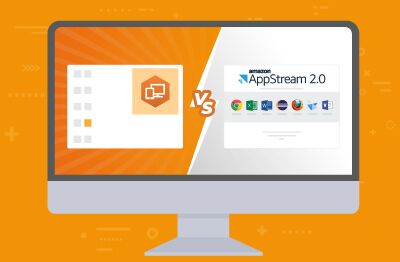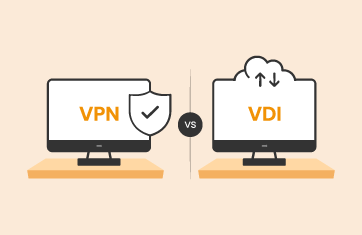AWS AppStream vs Workspaces – Difference between Amazon AppStream 2.0 and Amazon WorkSpaces
Amazon offers two different services, Amazon WorkSpaces and AppStream 2.0, that can be used to deliver apps remotely either streamed via a browser or within a virtual workspace (desktop). Once you understand the differences between the two services the choice is usually clear from the use case. It is in fact common for organizations to use a mixture of both.
What is Amazon AppStream 2.0?
Amazon AppStream 2.0 is the next-gen desktop streaming service. It allows organizations to publish individual applications that are then streamed to end users on any device using an HTML5 browser, providing those applications SaaS (Software as a Service).
Advantages:
- Ability to support access from a wide range of devices including tablets, thin clients, and workstations, including BYOD (bring your own device). Note: 19/April/2022 I’ve been informed by Amazon that there is a minimum resolution requirement of 768×1028 which may exclude the use of certain clients / smart phones.
- Eases the maintenance and lifecycle management of applications, a single centrally managed and definitive version of each application can be patched and managed.
- Many organizations have bespoke and legacy applications that require custom configurations (specific hardware, certain driver versions, and so on) and simply do not work when published to vanilla VDI (Virtual Desktop Infrastructure) or DaaS (Desktop as a Service) desktops or local machines. Moreover, when organizations have multiple custom or legacy apps, the customizations may conflict. Publishing such an application as SaaS via this next gen desktop streaming service resolves such considerations.
- Applications can be accessed on a wide range of OSs including Windows PC, Linux PC, Chromebooks, and Macs.
This latest desktop streaming service by AWS is well-suited as a cloud alternative to many on-premises use cases that implemented Citrix XenApp (CVAD), or apps hosted via Microsoft RDS, as well as CAD-in-a browser like options.
For ISVs (Independent Software Vendors) developing applications, this fully managed desktop service offers a platform they can use as a business model to supply their application titles as SaaS directly to customers. There is a good range of information for software vendors available on Amazon’s website (see Amazon AppStream 2.0 | Software Vendors). Benefits, beyond the above use cases, that appeal to software vendors include:
- The ease with which they can offer free trials.
- The ability to leverage Amazon’s vast, yet regionalized datacenters and infrastructure to expand to new customers and trial new markets.
- The wide end-point OS support can remove the need to port applications to various OSs reducing costs and accelerating time to market.
Indeed, many ISVs have already adopted the latest AppStream service, including heavyweight 3D and CAD/AEC application vendors such as Siemens, Dassault, and Autodesk. Amazon has a site where you can try out various sample apps for yourself; see: Amazon AppStream 2.0 Demo | Stream Applications on AWS.
| AppStream 2.0 can also be used to stream non-persistent desktops (both Linux and Windows) to users. A non-persistent desktop can suit many use cases very well, especially in scenarios such as call centers. |
What is Amazon WorkSpaces?
Amazon WorkSpaces is a cloud DaaS (Desktop as a Service) service, offering persistent digital workspaces hosted in VMs (Virtual Machines) on Amazon infrastructure. Amazon WorkSpaces can be used to provision either Windows or Linux desktops. Persistent workspaces offer desktops where the user data, applications, storage, and configurations persist beyond the life of a session and can be customized for individual users.
Typical use cases include:
- Replacing on premises VDI desktops using technologies, such as Citrix CVAD (was XenDesktop) and VMware Horizon view.
- As an alternative to traditional VDI vendor cloud options, such as Citrix Cloud, VMware Horizon Cloud.
- As a competitive offering to other native cloud digital workspace offerings, such as AVD (Azure Virtual Desktops) on Microsoft Azure.
This is the choice for those wanting to deliver the full-blown persistent desktop experience to users. Amazon WorkSpaces Application Manager (WAM) is often used in conjunction with Amazon WorkSpaces to deploy and manage applications for Amazon WorkSpaces. Amazon WAM accelerates software deployment, upgrades, patching, and retirement by packaging Microsoft Windows desktop applications into virtualized application containers.
Protocols used by Amazon AppStream 2.0 and WorkSpaces
The primary difference between AWS AppStream vs WorkSpaces lies in the protocol they use for streaming and delivering content to the end-user.
AppStream leverages a proprietary Amazon protocol using technologies acquired from the NICE DCV Acquisition. Since the acquisition, Amazon has invested heavily in this protocol, including some industry leading work on audio synchronization, particularly relevant for rich media and VFX editing like applications. There is an informative overview of the history of NICE DCV within Amazon on the AMD blog here.
Amazon WorkSpaces supports two different protocols: Teradici PCoIP and WorkSpaces Streaming Protocol (WSP). For those familiar with PCoIP from the VMware ecosystem, you should be aware that the legacy versions of PCoIP licensed by VMware differ from the newer technologies (PCoIP Ultra) licensed by Amazon and others. WSP is an in-house Amazon technology. Amazon provides information about how to choose between these protocols; see: Protocols for Amazon WorkSpaces – Amazon WorkSpaces. The protocol that you choose depends on several factors, such as the type of devices your users will be accessing their WorkSpaces from, which operating system is on your WorkSpaces, what network conditions your users will be facing, and whether your users require bidirectional video support.
Monitoring of Amazon AppStream 2.0 and WorkSpaces
As with any digital workspace technology, performance monitoring of virtual desktops deployed on the cloud is important. Performance metrics can be collected in different ways:
- Synthetic monitoring using software robots that check if the virtual desktop service is available and responsive.
- Integration with AWS CloudWatch to collect utilization metrics for Amazon WorkSpaces and AppStream.
- Insights into the virtual desktops obtained using light-weight agents deployed within the desktops. Often these agents are built into the images used to spin up the virtual desktops dynamically.
eG Enterprise provides capabilities for monitoring both Amazon WorkSpaces and AppStream from one console.
The eG Enterprise Logon Simulator for Amazon WorkSpaces, a part of the eG Enterprise, is a purpose-built synthetic monitoring solution for delivering proactive visibility into the logon performance in Amazon WorkSpaces infrastructures. Using an agentless approach, the eG Enterprise Logon Simulator for Amazon WorkSpaces simulates a user logging into an Amazon WorkSpaces client portal through a browser and accessing his/her desktop. By emulating the exact same process that users go through when they logon to Amazon WorkSpaces, the eG Enterprise Logon Simulator for Amazon WorkSpaces provides a realistic measure of the user experience during logon. Since every simulation tests the entire Amazon WorkSpaces infrastructure, the results represent the cumulative health of all the tiers supporting user logons. Beyond logon, eG Enterprise includes support for full session and thick apps simulations within Amazon WorkSpaces; see Synthetic Monitoring of Amazon Workspaces | eG Innovations. A similar capability is also available for Amazon AppStream as well.
Amazon Technologies and Hybrid and Multi-cloud Use Cases
Despite the differences between AWS AppStream vs WorkSpaces, both services can be utilized in tandem to address various use cases, with each offering unique advantages depending on the specific requirements.
Not only do many Amazon customers mix both AppStream and WorkSpaces technologies, but many also mix their usage with similar technologies used on-premises and alongside comparable products and services from alternative cloud vendors.
eG Enterprise provides a single-interface product solution to support such cases (see Digital Workspace Monitoring Solutions| eG Innovations). Statistics and data on industry trends mixing technologies are available here: Digital Workspaces in the New Normal 2021 Survey Report.
eG Enterprise is an Observability solution for Modern IT. Monitor digital workspaces,
web applications, SaaS services, cloud and containers from a single pane of glass.
Learn More:
- Amazon maintain a FAQ for WorkSpaces – see: Amazon WorkSpaces – FAQs – Amazon Web Services (amazonaws.cn)
- Learn how eG Enterprise can be used to proactively monitor and troubleshoot Amazon WorkSpaces, see: AWS WorkSpaces Monitoring and AWS WorkSpaces Monitoring Simplified with eG Enterprise Note: SaaS deployment options on AWS are available.
- How eG Enterprise addresses the 7 key needs of digital workspace professionals an overview of features and how they improve visibility into technologies such as Amazon WorkSpaces
- AWS Monitoring from eG to Find the Root Cause of Performance Issues (eginnovations.com) information on how the machine learning technologies within eG Enterprise’s powerful AIOps engine automates root-cause analysis, anomaly detection and intelligent alerting. Includes some details on our integration with AWS CloudWatch.
- Top 10 AWS Services Explained with Use Cases | eG Innovations
- There is a very insightful recent article from Amazon on AppStream 2.0 – Use Elastic fleets and Linux for inexpensive, secure bastion hosts in Amazon AppStream 2.0



